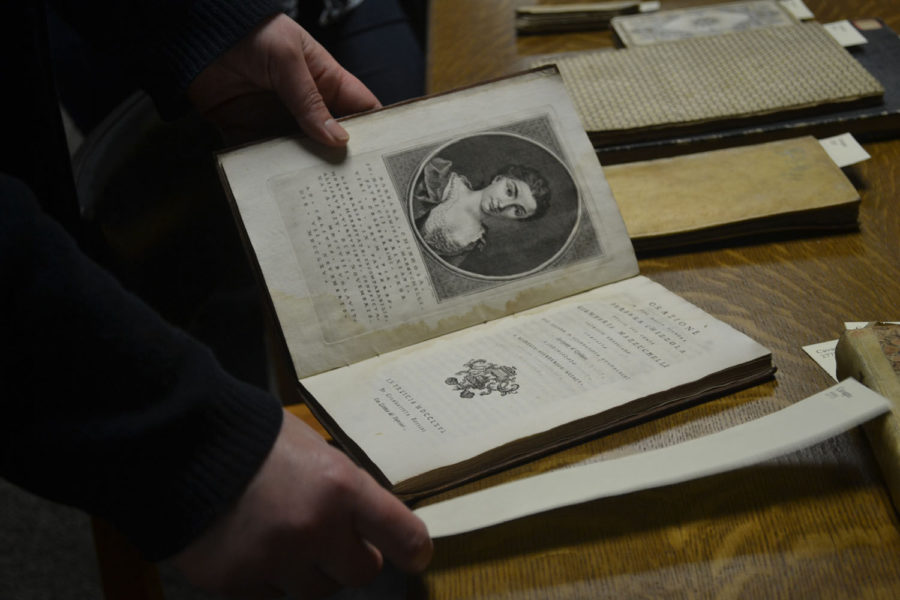Old books, new availability
Selected items from the Cavagna Book Collection, which comprises several unique Italian volumes that date as far back as the 15th century. They are currently in the process of being catalogued and are housed in the University’s Rare Book and Manuscript Library.
January 27, 2015
On the third floor of the University Main Library, staff members from the Rare Book & Manuscript Library are working to catalog and digitize a collection of around 20,000 books and manuscripts. Official cataloging began after receiving funding this past winter.
The collection has been housed at the University of Illinois since 1921. Although the books are centuries old, they have been preserved in a vault in the Rare Book & Manuscript Library at a controlled temperature and humidity level.
Chloe Ottenhoff, the lead cataloger of the project, said that before the University obtained the books, they belonged to a private collector from Alessandria, Italy, named Count Antonio Cavagna Sangiuliani di Gualdana.
Ottenhoff said the project is possible thanks to the Cataloging Hidden Special Collections and Archives grant from the Council on Library and Information Resources, which was created to catalog books that have been inaccessible in library systems because of lack of funding or resources.
In the Library’s cataloging room, each staff member has a station with a computer and an area to examine the book.
Get The Daily Illini in your inbox!
When a book is examined, it is cradled in between two foam pieces to support the spine of the book. Strings filled with sand or lead shot, called snakes, are draped over the corner to hold down the page without causing damage. Ottenhoff said the staff member enters information about each book into a computer program, analyzes the title for subject access, makes notes about any unique features and then moves on to the next item.
Ottenhoff said that after the books’ basic information is entered into the system, the Main Library’s Digital Content Creation office digitizes the books’ content. The overhead cameras and state-of-the-art processing system takes pictures of the pages that can be viewed as PDF files or Flipbooks online.
As the books are digitized, they are uploaded to an online database accessible not only to University of Illinois students, but also to scholars all over the world. Making the books available to other researchers unearths information on Italian history, daily life and printing processes of the time.
“Whoever wants to use this material, we welcome it,” said Rosemary Trippe, one of the project catalogers.
Groups from Chicago and Italy have already expressed interest in studying the texts.
“It’s going to be a really phenomenal resource for Italian studies,” Ottenhoff said.
She hopes that this will lead to a stronger Italian studies program at the University and help form connections with other research groups who could use the collection.
Nathan Evans is a graduate student in library science who is working as an assistant on the project. He said cataloging the books has expanded his knowledge of the Italian language, culture and history.
“There are books on so many topics and subjects that I am learning things that I never would have otherwise,” Evans said.
Trippe said that the collection of books contains some objects that were more luxurious, such as official, beautifully bound books that were too costly for some to access. Others were used by everyone in that time period, such as pocket almanacs containing information about post office schedules and holidays. The books were worth their price because they acted as one of the only sources of information and entertainment of the day.
To put it in more modern terms, Trippe said, “Think how much we pay to have a smartphone in our pocket.”
At times, the project has its challenges. Some books lack a clear title or the author’s name because the title page or cover is missing. The staff then has to determine a way to classify the book based on content or conduct research in biographical dictionaries and bibliographies.
Ottenhoff said that when the collection first arrived on campus, books were spread to different departmental libraries. As the project continues, one of the staff’s tasks is to locate all of the books so they can be categorized together under the name “Cavagna Collection.”
Trippe has a background in the Italian language and said she found the Italian dialects in the books to be incredibly interesting. However, dialects of Italian, especially in areas such as Milan, can be difficult to understand. Sometimes the staff members have to phonetically sound out the words to interpret words that are not spelled traditionally. When working with books as old as these, there is always the potential for new facts or revelations.
“It’s a constant discovery,” Ottenhoff said.
Because the Cavagna Collection contains books dating from the 1600s to the 1900s, a modernization in the printing styles can be seen as the books are cataloged. Ottenhoff said that books published after the 1820s are most likely to have been printed on early steam powered mechanical printing presses, but older books would have required the craftsman to individually place each letter into a hand press to form words on the page.
Sarah Lindenbaum, another project cataloger, said certain books contain handwritten notes because when they were published, paper was not as accessible or cheap as it is today. The staff has found blank pages in the books that were used to record names, shopping lists and even one man’s gambling debt.
The grant will last for three years, and the staff hopes to have the entire collection catalogued by that time. They update their findings on the Library’s Non Solus Blog.
Isabella can be reached at [email protected].







